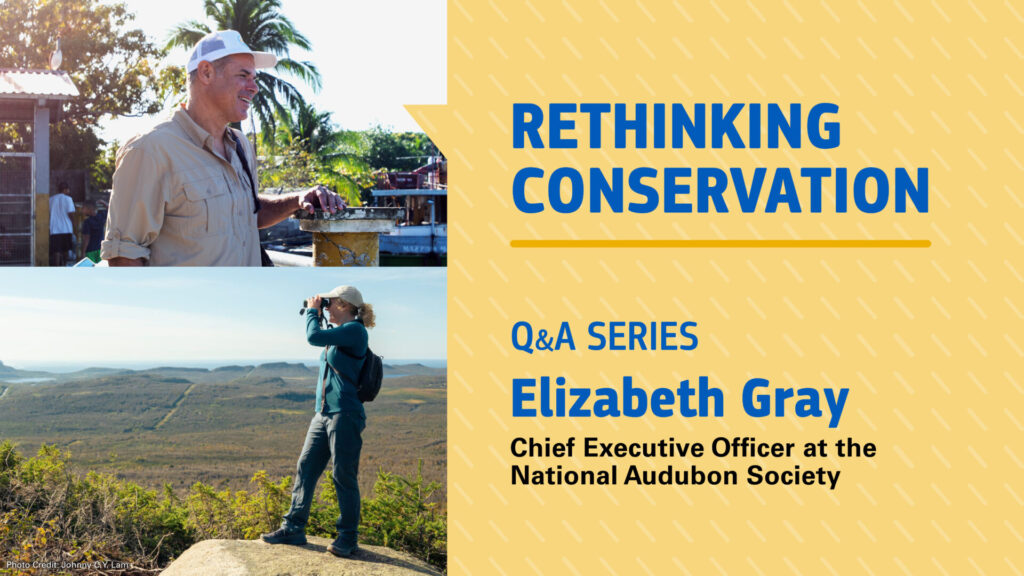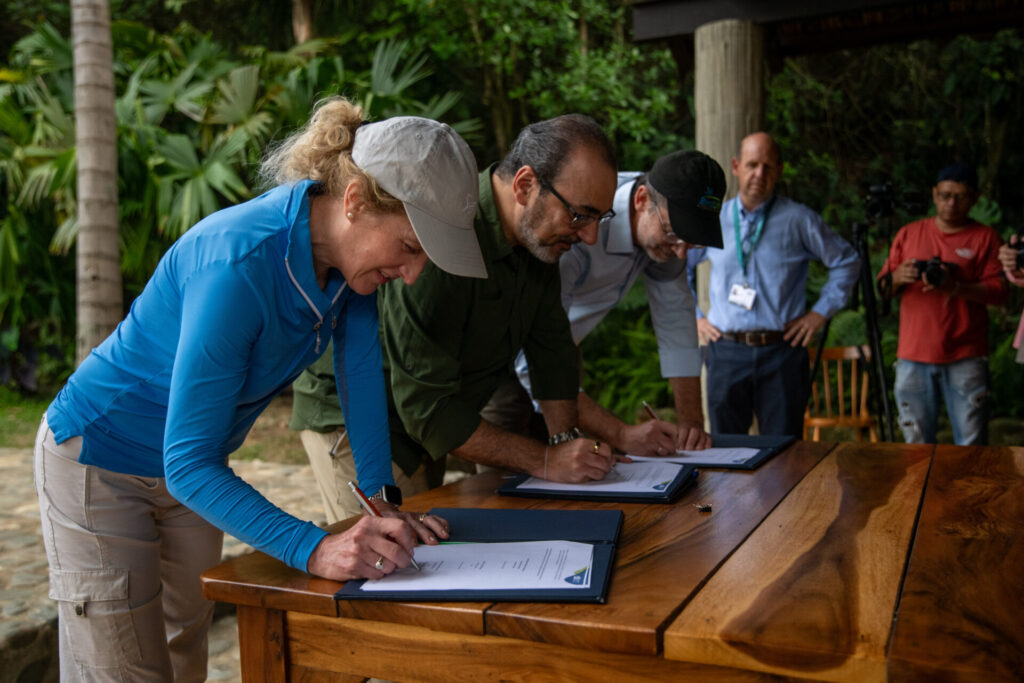
In this Q&A, Rare President Caleb McClennen, Ph.D., interviews Elizabeth Gray, Chief Executive Officer of the National Audubon Society, to explore how the organization is leveraging behavioral science, community leadership, and cross-continental partnerships to scale impact for birds and people alike. Part of Rare’s Rethinking Conservation series, this conversation builds on the need to view people as central to solving the biodiversity and climate crises. Through discussions with forward-thinking experts, the series explores innovative strategies and collaborative solutions that empower communities, advance conservation, and redefine our relationship with nature.
Caleb: Thanks so much for joining this conversation. I’m thrilled to dive into the vital role of behavior change in bird conservation with you. You’ve long been a leader in this space, and it’s especially meaningful given our shared roots: Rare actually began as a project within Audubon back in the 1970s!
To kick us off, tell us what you are doing differently today to mobilize people in ways that go beyond traditional awareness campaigns.
Elizabeth: Birds are our superpower. They cross borders, build bridges, and remind us of what is still possible. When we follow their lead, we drive lasting change.
At Audubon, we are building on 120 years of trusted leadership grounded in science and powered by the unifying force of birds. That starts with scale. Birds move across continents, and our conservation strategy does too. We are protecting and restoring millions of acres of habitat across the Americas, accelerating clean energy solutions that work for people and wildlife, and shaping policy that meets the urgency of the climate and biodiversity crises.
But scale is also about how we include people in our strategy. For decades, programs like the Christmas Bird Count have built a foundation of community science. Now, we are expanding that legacy through our Migratory Bird Initiative, which makes data from hundreds of organizations accessible through the Bird Migration Explorer. Tools like real-time Motus tracking help us pinpoint the most critical stopover and breeding sites for hundreds of species, helping direct conservation where it matters most. And we are growing our campus chapter program to support emerging conservation leaders and working with partners to build connected corridors of habitat across the hemisphere.
Caleb: Conservation has traditionally focused on birds, not people. At Rare, people are central to solving the biodiversity crisis. Do you think the field has been too slow to recognize that saving birds requires changing human behavior first?
Elizabeth: Yes. I am a behaviorist by training, and I have always believed that understanding behavior — what people value, what motivates them to act, and what shapes their choices — is at the heart of creating change that lasts.
For too long, conservation has focused on protecting ecosystems without fully engaging the people who live within them and rely on them. But to halt and reverse biodiversity loss, we need to understand the social, cultural, and economic factors shaping decisions.
At Audubon, we design our work around how people live, work, and lead, co-creating conservation strategies that reflect local priorities and global goals. It includes building a hemispheric network of supporters, leaders, and scientists who understand that saving birds is about more than species — it is about protecting the systems that support all life.
Caleb: Community engagement is key to lasting change. Our work emphasizes that conservation succeeds when solutions are locally driven. How is Audubon ensuring that local voices and social norms shape its bird conservation strategies?
Elizabeth: Community leadership is also central to how we work. With 31 Conservation Action Centers, 29 sanctuaries, hundreds of local chapters, and grassroots partners across the hemisphere, we stay close to the people who know these places best.
We start by listening and shaping conservation strategies together. In Colombia, we co-develop birding trails with local communities that link conservation with sustainable tourism. Through Plants for Birds, we help people create habitat using native plants — turning backyards, parks, and shared spaces into stopover sites for migratory birds. Our Coastal Bird Stewardship Program trains volunteers to protect nesting birds and engage beachgoers.
This is core to Flight Plan — Audubon’s strategy for science-based, community-centered conservation across the hemisphere. It is how we connect what matters to people with what birds need to thrive.

Caleb: Birds don’t vote, but people do. How are you using behavioral science to shift individual actions and influence policies that protect bird habitats at scale?
Elizabeth: Behavioral science helps us understand what drives people to act and how individual choices build broader change. We use those insights to shape how we engage communities, earn trust, and build momentum for policies that protect birds and their habitats.
Our Bird-Friendly Buildings initiative is a powerful example. Every year, up to a billion birds in the U.S. die after colliding with buildings. Our Lights Out campaign educates and supports building owners, businesses, and individuals on how to turn off unnecessary lights during peak migration seasons. What starts with one building grows into community action, and then policy. Cities across the hemisphere are now adopting bird-safe building standards that save millions of birds yearly.
People are more likely to act when they feel part of something bigger. Policy is how we realize impact at scale, birds create a sense of connection, and people are how we get there.
Caleb: Looking ahead, Rare and Audubon share a commitment to scaling impact. How do you see behavior-based conservation shaping the future of Audubon’s work — and what role do partnerships play?
Elizabeth: Behavior-based conservation is one of the most powerful tools we have. At Audubon, it is central to our work to bend the bird curve — to halt and ultimately reverse the decline of birds across the Americas. That is our guiding star.
Reaching it takes strong science, smart policy, strong partnerships, and a deep understanding of how people relate to nature, to each other, and to change.
We are working with ranchers through Audubon Conservation Ranching to restore millions of acres of grasslands, collaborating with scientists to close critical migration data gaps, and joining with global organizations like Rare to share learning and accelerate impact. We know we are more effective when we all work together.
Behavioral science helps us understand how change starts and what keeps it moving. Partnerships help us turn that knowledge into real-world impact. And birds remind us what is at stake — and why there is still so much worth fighting for.
Dig into Rare’s journey from Audubon project to global conservation innovator.
Top photo credit: Jair F. Coll